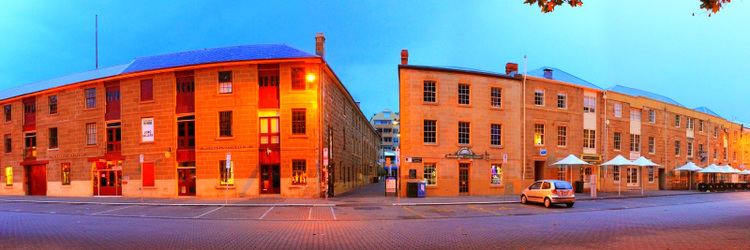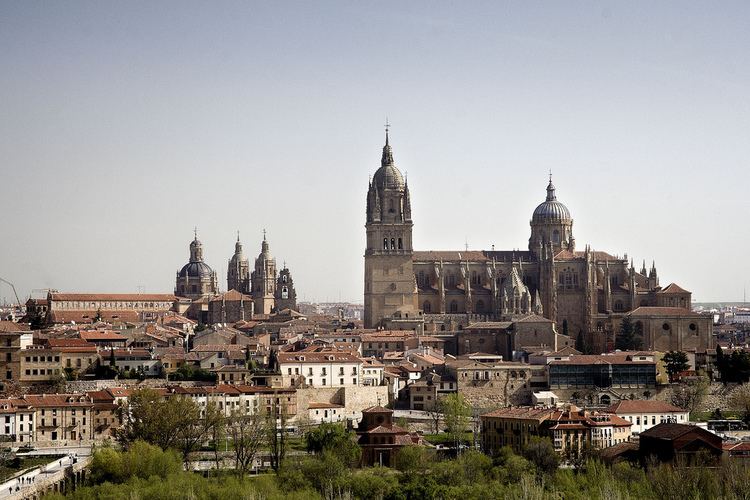Country | Population 152,048 (2012) Area 38.6 km2 | |
 | ||
Points of interest University of Salamanca, New Cathedral - Salamanca, Convento de San Esteban - Salamanca, Casa de las Conchas, Old Cathedral - Salamanca Colleges and Universities University of Salamanca, Pontifical University of Salamanca, Royal Scots College | ||
Mayor Alfonso Fernando Fernandez Manueco (Partido Popular) | ||
Map of Salamanca
Salamanca ([salaˈmaŋka]) is a city in northwestern Spain that is the capital of the Province of Salamanca in the community of Castile and León. The city lies on several hills by the Tormes River. Its Old City was declared a UNESCO World Heritage Site in 1988. With a metropolitan population of 228,881 in 2012 according to the National Institute of Statistics (INE), Salamanca is the second most populated urban area in Castile and León, after Valladolid (414,000), and ahead of León (187,000) and Burgos (176,000).
Contents
- Map of Salamanca
- Spanish live it in salamanca
- History
- Main sights
- Squares and public spaces
- Religious buildings
- University buildings
- Palaces and palatial houses
- Museums
- Others
- University
- Climate
- Economy
- Industry
- Road
- Airport
- Public transport
- Culture and sports
- Holy Week
- Other
- Sports
- Teams based in Salamanca
- Cinema
- Gastronomy
- Notable people
- References

It is one of the most important university cities in Spain and supplies 16% of Spain's market for the teaching of the Spanish language. Salamanca attracts thousands of international students.

It is situated approximately 200 kilometres (120 miles) west of the Spanish capital Madrid and 80 km (50 mi) east of the Portuguese border. The University of Salamanca, which was founded in 1218, is the oldest university in Spain and the fourth oldest western university, but the first to be given its status by the Pope Alexander IV who gave universal validity to its degrees. With its 30,000 students, the university is, together with tourism, a primary source of income in Salamanca.

Spanish live it in salamanca
History

The city was founded in the pre-Ancient Rome period by the Vaccaei, a Celtic tribe, or the Vettones, a Celtic or pre-Celtic indo-European tribe, as one of a pair of forts to defend their territory near the Duero river. In 220 BC Hannibal laid siege to the city and captured it. With the fall of the Carthaginians to the Romans, the city of Helmantica, as it was known, began to take more importance as a commercial hub in the Roman Hispania due to its favorable location. Salamanca lay on a Roman road, known as the Vía de la Plata, which connected it with Emerita Augusta (present day Mérida) to the south and Asturica Augusta (present-day Astorga) to the north. Its Roman bridge dates from the 1st century, and was a part of this road.
With the fall of the Roman Empire, the Alans established in Lusitania, and Salamanca was part of this region. Later the city was conquered by the Visigoths and included in their territory. The city was already an episcopal see, and signatures of bishops of Salamanca are found in the Councils of Toledo.
Salamanca surrendered to the Moors, led by Musa bin Nusair, in the year 712 AD. For years, this area between the south of Duero River and the north of Tormes River, became the main battlefield between the Christian kingdoms and the Muslim Al-Andalus rulers. The constant fighting of the Kingdom of León first, and the Kingdom of Castile and León later against the Caliphate depopulated Salamanca and reduced it to an unimportant settlement. After the battle of Simancas (939) the Christians resettled this area. After the capture of Toledo by Alfonso VI of León and Castile in 1085, the definitive resettlement of the city took place. Raymond of Burgundy, instructed by his father-in-law Alfonso VI of León, led a group of settlers of various origins in 1102.
One of the most important moments in Salamanca's history was the year 1218, when Alfonso IX of León granted a royal charter to the University of Salamanca, although formal teaching had existed at least since 1130. Soon it became one of the most significant and prestigious academic centres in Europe.
During the 16th century, the city reached its height of splendour (around 6,500 students and a total population of 24,000). During that period, the University of Salamanca hosted the most important intellectuals of the time; these groups of mostly-Dominican scholars were designated the School of Salamanca. The juridical doctrine of the School of Salamanca represented the end of medieval concepts of law, and founded the fundamental body of the ulterior European law and morality concepts, including rights as a corporeal being (right to life), economic rights (right to own property) and spiritual rights (rights to freedom of thought and rights related to intrinsic human dignity).
In 1551, the Holy Roman Emperor Charles V ordered an inquiry to find out if the science of Andreas Vesalius, physician and anatomist, was in line with Catholic doctrine. Vesalius came to Salamanca that same year to appear before the board and was acquitted.
Salamanca suffered the general downturns of the Kingdom of Castile during the 17th century, but in the 18th century it experienced a rebirth. In this period, the new baroque Cathedral and main square (Plaza Mayor) were finished.
In the Peninsular War of the Napoleonic campaigns, the Battle of Salamanca, in which an Anglo-Portuguese Army led by Wellington decisively defeated the French army of Marmont, was fought on 22 July 1812. The western quarter of Salamanca was seriously damaged by cannon fire. The battle which raged that day is famous as a defining moment in military history and many thousands of men were killed in the space of only a few short hours.
During the devastating Spanish Civil War (1936–39) the city quickly went over to the Nationalist side and was used as the de facto capital. Franco was named Generalissimo on 21 September 1937 while at the city, and in the same year was formed, by a decree signed in the city, the official fascist party that ruled Spain until the end of the Francoist regime, officially suppressing any other political party. The Nationalists soon moved most of the administrative departments to Burgos, which being more central was better suited for this purpose. However, some administrative departments, Franco's headquarters (located at the Palacio Episcopal, next to the Old Cathedral) and the military commands stayed in Salamanca, along with the German and Italian fascist delegations, making it the de facto Nationalist capital and centre of power during the entire civil war. Like much of fervently Catholic and largely rural Leon and Old Castile regions, Salamanca was a staunch supporter of the Nationalist side and Francisco Franco's regime for its long duration.
In 1988, the old city was declared a UNESCO World Heritage Site. In 1998, it was declared a European Capital of Culture for year 2002 (shared with Bruges). During 14 and 15 October 2005, it hosted the XV the Ibero-American Summits of Heads of State and Governments.
Since 1996, Salamanca has been the designated site of the archives of the Spanish Civil War (Archivo General de la Guerra Civil Española). The original documents were assembled by the Francoist regime, selectively obtained from the administrative departments of various institutions and organizations during the Spanish Civil War as a repressive instrument used against opposition groups and individuals. The socialist government moved the Catalan part of the archive to Barcelona in 2006 despite opposition from the local authorities and popular protests.
Main sights
The Old City of Salamanca was declared a World Heritage Site by UNESCO in 1988. Sightseeing in the city, many of them within the old quarter, are:
Squares and public spaces
Religious buildings
University buildings
Palaces and palatial houses
Museums
It is accessed from the last tower, next to the gate of Santa Lucía (giving access to the old cathedral). In three of the rooms one can find exposed drawings, documents and religious objects related to the cathedrals; especially with its construction, one can see, both inside and outside the two cathedrals. From the "Sala del Alcaide" enjoy a splendid view of the nave and the altar of the old cathedral, and from the upper platform located thereupon, one may accurately observe the Tower del Gallo, as well as views of the Tormes and Transtormes neighborhoods. One may also enjoy the vaults of the new cathedral, and again on the outside with views of the plaza Anaya, the Tower del Reloj, the Rua Mayor and all of the historical centre.
Others
Nearby are the Mudéjar Romanesque church of Santiago (modern reconstruction) and the stone bull quoted in Lazarillo de Tormes.
University
The University of Salamanca was founded in 1134 and in 1218 it was given the royal charter of foundation ("Estudio General") by Alfonso IX of León. It was the first university to receive the title of "University" in 1254. Under the patronage of the learned Alfonso X, its wealth and reputation greatly increased (1252–1282), and its schools of canon law and civil law attracted students even from the Universities of Paris and Bologna. In the 16th century, the city's fortunes depended on those of the University. About the time Christopher Columbus was lecturing there on his discoveries, Hernán Cortés took classes at Salamanca, but returned home in 1501 at age 17, without completing his course of study. (About ten years later the conquistador Francisco Vásquez de Coronado was born in Salamanca.)
Climate
Salamanca has a cold semi-arid climate (BSk), bordering on a warm-summer Mediterranean climate (Csb) according to the Köppen climate classification, with cool winters, and warm dry summers due to the altitude.
Economy
The city's economy is dominated by the university and tourism, but other sectors including agriculture and livestock rearing along with construction and manufacturing are also significant. Not surprisingly, in December 2007 83% of the working population, equivalent to 55,838, were employed in the service sector.
Industry
Industrial activity accounted for 5% of the working population, or 3,340 workers employed over 360 businesses. Two of the largest businesses, both of them numbered among the largest 100 enterprises in the region, are the veterinary vaccine manufacturer "Laboratorios Intervet", and the fertilizer specialist manufacturers S.A. Mirat, which is the city's oldest industrial company, having been established originally as a starch factory in 1812.
Road
Highways
Other roads
Airport
Salamanca Airport, located in the military base of Matacán, is located about 14 km (9 mi) east of the city.
Public transport
There are 13 bus lines during the day and two night lines. Also, a tram line has been projected.
Culture and sports
The Old City of Salamanca was declared a UNESCO World Heritage Site in 1988. In 2002 Salamanca shared the title of European Capital of Culture with Bruges. In 2005, Salamanca celebrated the 250th anniversary of the construction of the Plaza Mayor with a number of European events (Plaza Mayor de Europa).
Holy Week
The Holy Week in Salamanca (Semana Santa) is the most well-known of Salamanca's festivals. Salamanca is renowned for the solemn and sober processions celebrated during Holy Week. 16 confraternities, 10.000 brothers or "cofrades", 50 floats or "pasos" celebrate the Passion of Christ with 20 processions and thousands of followers, tourist and visitors.
Some of the celebrations have been performed for centuries. The confraternities carry artistic pasos created by important Spanish artists such as Luis Salvador Carmona, Alejandro Carnicero or Mariano Benlliure. in 2003 the Semana Santa of Salamanca obtained the official declaration of International Touristic Interest.
Other
Salamanca is also famous throughout Spain and the rest of Europe for its celebrations of "Nochevieja Universitaria," loosely translated as "University New Year". It is usually held on the Thursday of the last week of school in December and two weeks before the real New Year's Eve. On this day, students congregate in the Plaza Mayor, Salamanca to watch free performances and take part in the countdown to midnight.
Sports
Salamanca offers the amenities of a larger city while retaining an intimate small town atmosphere. Since 1923, "Los Charros", formally the Union Deportiva Salamanca, have been the Salamanca football team. In 2013, the club went bankrupt and its activities were abandoned. After its dissolution, some managers of the entity decided to refound the farm team to continue competing, maintaining the legacy of the historic club. Thus they created the Club de Fútbol Salmantino.
The first high jump over 8 feet (2.44 m) was made in Salamanca, by Javier Sotomayor in 1993. His jump, of 2.45 m (8 feet 0.46 inch), is still the world record in the event.
Teams based in Salamanca
Cinema
With its old streets being ideal for historical film settings Salamanca has been used several times in cinematic productions, including 1492: Conquest of Paradise by Ridley Scott and Goya's Ghosts by Miloš Forman. Salamanca was also the setting for the 2008 political thriller Vantage Point, although the movie was almost exclusively filmed in Mexico.
Gastronomy
Salamanca has a very interesting and distinctive gastronomy. Among many dishes, Chanfaina (steamed rice with pork) is very popular. Another classic dish of the Salamancan, known as Charreria ("peasant lands"), is a cocido, a slow-cooked casserole including chickpeas. However, Hornazo, a meat pie, is the most popular dish of all.
